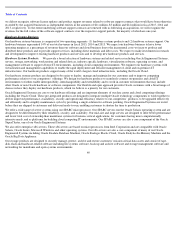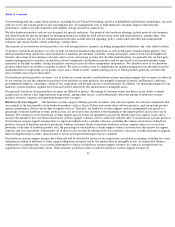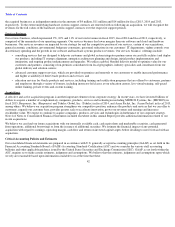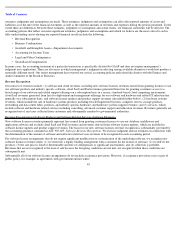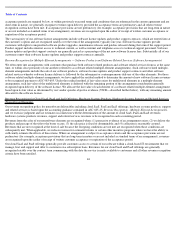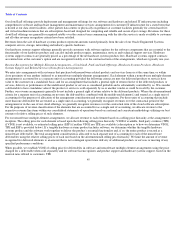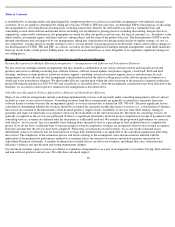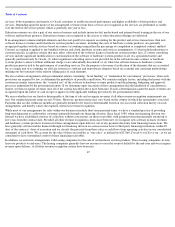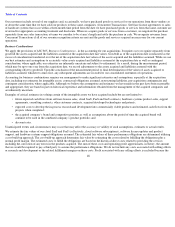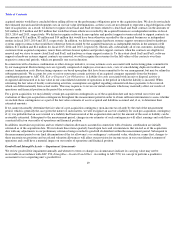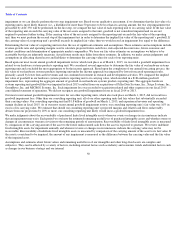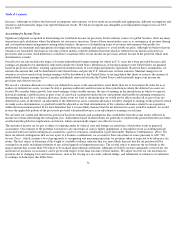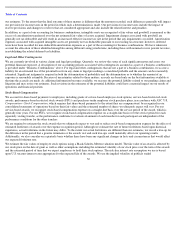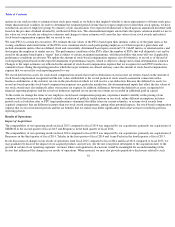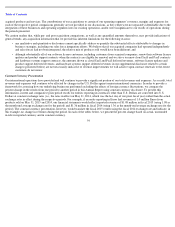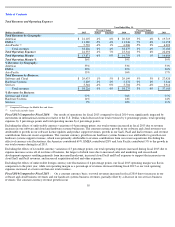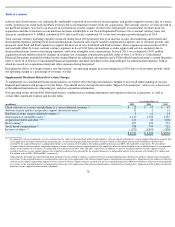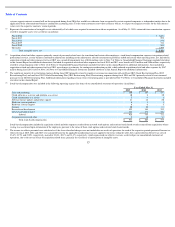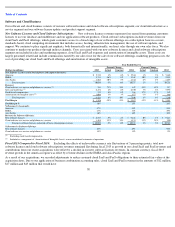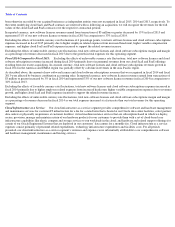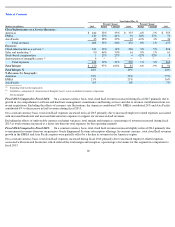Oracle 2014 Annual Report Download - page 54
Download and view the complete annual report
Please find page 54 of the 2014 Oracle annual report below. You can navigate through the pages in the report by either clicking on the pages listed below, or by using the keyword search tool below to find specific information within the annual report.
Table of Contents
impairment or we can directly perform the two step impairment test. Based on our qualitative assessment, if we determine that the fair value of a
reporting unit is more likely than not (i.e., a likelihood of more than 50 percent) to be less than its carrying amount, the two step impairment test
prescribed by ASC 350 will be performed. In the first step, we compare the fair value of each reporting unit to its carrying value. If the fair value
of the reporting unit exceeds the carrying value of the net assets assigned to that unit, goodwill is not considered impaired and we are not
required to perform further testing. If the carrying value of the net assets assigned to the reporting unit exceeds the fair value of the reporting
unit, then we must perform the second step of the impairment test in order to determine the implied fair value of the reporting unit’s goodwill. If
the carrying value of a reporting unit’s goodwill exceeds its implied fair value, then we would record an impairment loss equal to the difference.
Determining the fair value of a reporting unit involves the use of significant estimates and assumptions. These estimates and assumptions include
revenue growth rates and operating margins used to calculate projected future cash flows, risk-adjusted discount rates, future economic and
market conditions and determination of appropriate market comparables. We base our fair value estimates on assumptions we believe to be
reasonable but that are inherently uncertain. Actual future results may differ from those estimates. In addition, we make certain judgments and
assumptions in allocating shared assets and liabilities to determine the carrying values for each of our reporting units.
Based upon our most recent annual goodwill impairment review which took place as of March 1, 2015, we recorded a goodwill impairment loss
related to our hardware systems products reporting unit. We considered several approaches to determine the fair value of our hardware systems
reporting unit and concluded the most appropriate to be the income approach. Based upon the completion of our annual forecasting process, the
fair value of our hardware systems products reporting unit under the income approach was impacted by lower forecasted operating results,
primarily caused by lower forecasted revenues and our continued investment in research and development activities. We compared the implied
fair value of goodwill in our hardware systems products reporting unit to its carrying value, which resulted in a $186 million goodwill
impairment loss, representing the aggregate amount of goodwill in our hardware systems products reporting unit. The aggregate hardware
systems reporting unit goodwill that was impaired in fiscal 2015 resulted from our acquisitions of Pillar Data Systems, Inc., Xsigo Systems, Inc.,
GreenBytes, Inc. and MICROS Systems, Inc. Such impairment loss was recorded to acquisition related and other expenses in our fiscal 2015
consolidated statement of operations. We did not recognize any goodwill impairment losses in fiscal 2014 or 2013.
Our most recent annual goodwill impairment review for our other reporting units, which also took place on March 1, 2015, did not result in a
goodwill impairment loss. Other than our consulting reporting unit, all of our other reporting units had fair values that substantially exceeded
their carrying values. Our consulting reporting unit had $1.8 billion of goodwill on March 1, 2015, and experienced revenue and operating
margin declines in fiscal 2015. As of our most recent annual goodwill impairment review, our consulting reporting unit’s fair value was 16% in
excess of its carrying value. We estimate that should our consulting reporting unit’s projected margins and related cash flows unfavorably
deviate from our projections by 20% or more, our consulting reporting unit likely would incur a goodwill impairment loss.
We make judgments about the recoverability of purchased finite lived intangible assets whenever events or changes in circumstances indicate
that an impairment may exist. Each period we evaluate the estimated remaining useful lives of purchased intangible assets and whether events or
changes in circumstances warrant a revision to the remaining periods of amortization. Recoverability of finite lived intangible assets is measured
by comparison of the carrying amount of the asset to the future undiscounted cash flows the asset is expected to generate. We review indefinite
lived intangible assets for impairment annually and whenever events or changes in circumstances indicate the carrying value may not be
recoverable. Recoverability of indefinite lived intangible assets is measured by comparison of the carrying amount of the asset to its fair value. If
the asset is considered to be impaired, the amount of any impairment is measured as the difference between the carrying value and the fair value
of the impaired asset.
Assumptions and estimates about future values and remaining useful lives of our intangible and other long-lived assets are complex and
subjective. They can be affected by a variety of factors, including external factors such as industry and economic trends and internal factors such
as changes in our business strategy and our internal
50


